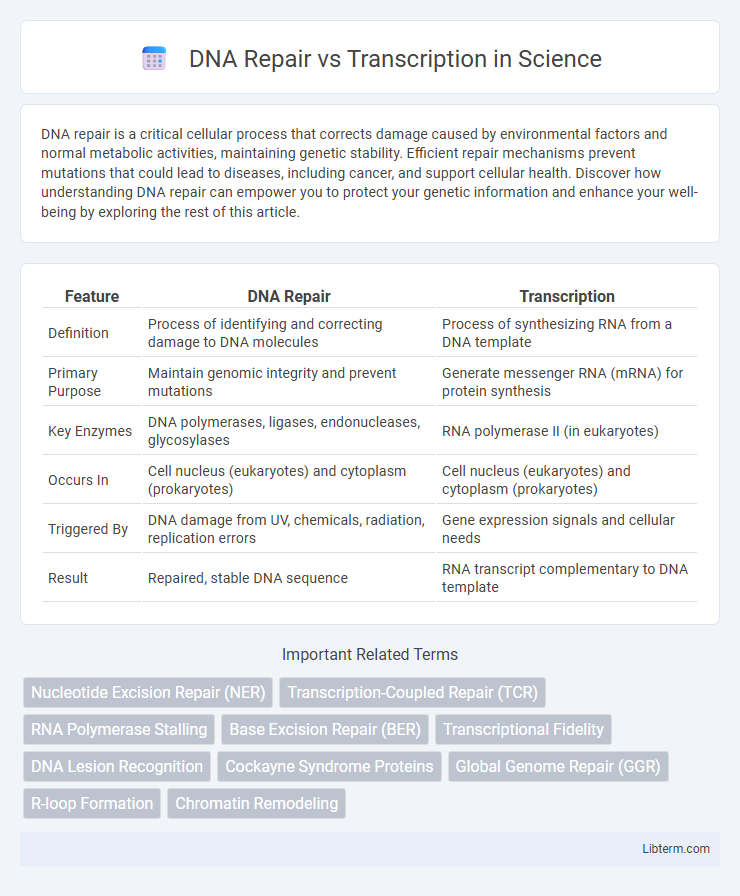DNA repair is a critical cellular process that corrects damage caused by environmental factors and normal metabolic activities, maintaining genetic stability. Efficient repair mechanisms prevent mutations that could lead to diseases, including cancer, and support cellular health. Discover how understanding DNA repair can empower you to protect your genetic information and enhance your well-being by exploring the rest of this article.
Table of Comparison
| Feature | DNA Repair | Transcription |
|---|---|---|
| Definition | Process of identifying and correcting damage to DNA molecules | Process of synthesizing RNA from a DNA template |
| Primary Purpose | Maintain genomic integrity and prevent mutations | Generate messenger RNA (mRNA) for protein synthesis |
| Key Enzymes | DNA polymerases, ligases, endonucleases, glycosylases | RNA polymerase II (in eukaryotes) |
| Occurs In | Cell nucleus (eukaryotes) and cytoplasm (prokaryotes) | Cell nucleus (eukaryotes) and cytoplasm (prokaryotes) |
| Triggered By | DNA damage from UV, chemicals, radiation, replication errors | Gene expression signals and cellular needs |
| Result | Repaired, stable DNA sequence | RNA transcript complementary to DNA template |
Overview of DNA Repair and Transcription
DNA repair mechanisms maintain genomic stability by correcting damaged DNA strands caused by environmental factors and replication errors, employing pathways such as base excision repair, nucleotide excision repair, and homologous recombination. Transcription is the process by which RNA polymerase synthesizes messenger RNA (mRNA) from DNA templates, regulating gene expression essential for cellular function and response to stimuli. Both DNA repair and transcription are interconnected processes where transcription-coupled repair specifically targets lesions on transcribed DNA strands to ensure accurate gene expression.
Key Differences Between DNA Repair and Transcription
DNA repair involves specialized enzymes like DNA ligases and polymerases that detect and correct damaged or mismatched bases to maintain genomic integrity. Transcription is the process by which RNA polymerase synthesizes messenger RNA from a DNA template, enabling gene expression. Unlike transcription, DNA repair does not produce RNA transcripts but restores DNA sequence fidelity to prevent mutations.
Molecular Mechanisms of DNA Repair
Molecular mechanisms of DNA repair involve multiple pathways such as nucleotide excision repair (NER), base excision repair (BER), and homologous recombination (HR) that identify and correct DNA damage to maintain genomic integrity. During transcription, RNA polymerase can stall at DNA lesions, triggering transcription-coupled repair (TCR), a sub-pathway of NER that specifically targets transcription-blocking damage. These coordinated repair processes ensure accurate gene expression and prevent mutations by resolving DNA damage encountered during transcription.
Stages of Transcription Process
The transcription process involves initiation, elongation, and termination stages, each critical for accurate RNA synthesis. DNA repair mechanisms interact predominantly during elongation, where RNA polymerase can detect DNA damage and recruit repair proteins to maintain genome integrity. Efficient coordination between transcription and DNA repair ensures transcription fidelity and prevents mutations.
DNA Damage Impact on Transcription Fidelity
DNA damage can severely compromise transcription fidelity by causing RNA polymerase to stall or misincorporate nucleotides, leading to erroneous mRNA sequences and defective proteins. Repair mechanisms like transcription-coupled nucleotide excision repair (TC-NER) specifically target lesions on the transcribed DNA strand to promptly restore transcription accuracy. The efficiency of DNA repair pathways directly influences gene expression integrity and cellular function by preventing mutation accumulation during transcription.
Cross-talk Between DNA Repair and Transcription Pathways
DNA repair mechanisms and transcription pathways engage in critical cross-talk to maintain genomic integrity and proper gene expression. Nucleotide excision repair (NER) selectively targets DNA lesions that stall RNA polymerase II during transcription, facilitating transcription-coupled repair (TCR) to rapidly resolve damage in actively transcribed regions. This coordinated interaction ensures swift restoration of DNA templates, preventing transcriptional arrest and preserving cellular homeostasis.
Major Enzymes Involved in Both Processes
DNA repair and transcription involve critical enzymes that maintain genomic integrity and gene expression, respectively. Key enzymes in DNA repair include DNA polymerases, ligases, endonucleases, and helicases, which recognize and excise damaged nucleotides before synthesizing and sealing new DNA strands. In transcription, RNA polymerase is the primary enzyme synthesizing RNA from a DNA template, while transcription factors regulate its activity and ensure accurate gene expression.
Biological Significance and Genetic Stability
DNA repair mechanisms are crucial for correcting damage and maintaining genetic stability by preventing mutations during transcription. Efficient repair processes ensure accurate RNA synthesis and proper gene expression, safeguarding cellular function and integrity. Disruptions in DNA repair can lead to transcription errors, genomic instability, and increased risk of diseases such as cancer.
Disorders Linked to DNA Repair and Transcription Malfunctions
Defects in DNA repair mechanisms such as nucleotide excision repair and base excision repair contribute to disorders like Xeroderma Pigmentosum and Cockayne Syndrome, causing accumulation of DNA damage and transcriptional stalling. Mutations affecting transcription-coupled repair exacerbate neurodegenerative diseases by impairing resolution of transcription-blocking lesions, leading to cellular dysfunction. Disruptions in both DNA repair and transcription pathways are linked to cancer development, highlighting the critical role of genome stability maintenance.
Future Perspectives in DNA Repair and Transcription Research
Emerging technologies such as CRISPR-based gene editing and single-molecule imaging are poised to revolutionize the understanding of DNA repair mechanisms and transcription regulation. Integrative multi-omics approaches will enable comprehensive mapping of DNA damage response pathways and transcription factor dynamics, facilitating precise therapeutic interventions for cancer and genetic disorders. Advances in artificial intelligence and machine learning will accelerate the identification of novel repair proteins and transcriptional modulators, paving the way for personalized medicine targeting genomic instability.
DNA Repair Infographic

 libterm.com
libterm.com